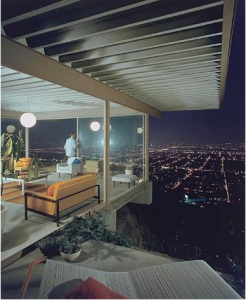
For many, the name “Julius Shulman” does not ring a bell. Why should it? After all, the creative brilliance of the late American architectural photographer was often disguised by the well-known architecture he chose to photograph. For example, when viewing Shulman’s images of a Frank Lloyd Wright home or a Pierre Koenig structure, it is almost impossible to think of anything other than the extraordinary architecture itself. What about the man behind the lens? Julius Shulman was responsible for bringing to light and enhancing the beauty of an art form through creative use of another art form. He was the bridge between architecture and photography; linking his own vision with that of great architectural masters to create photography that is best represented by the word, “WOW.”
Born in Brooklyn in 1910, Shulman began to pursue photography purely by chance. One afternoon as a young adult living in Los Angeles, he took a picture of a Richard Neutra house with a Kodak camera. His photograph was passed along to Neutra, who was so pleased with it that he encouraged Shulman to purchase a view camera in order to photograph more of his designs. While studying at Berkeley, he began printing his photographs and selling them in small bookstores around town. His efforts were rewarded by a steady demand for more photographs.
Eventually, California’s beauty and the uniqueness of western design reached the eastern United States through Julius Shulman’s camera. His internal love of nature shone through his work. In fact, the photographer always got his best ideas by walking around the outside of whatever building or buildings he planned to photograph. His work is unique in that he used people in his images to give scale to the buildings and personality to his pictures. Shulman did not use tricks to illuminate his pictures; he had an incisive vision and an eye that recognized the importance of light to a building.
Shulman died at his home in Los Angeles, California in 2009 after a successful career that spanned over fifty years. He was the subject of a 2008 documentary film, Visual Acoustics: The Modernism of Julius Shulman, and he wrote and consulted on a number of books that belong just as much in one’s library collection as they do on one’s coffee table. His legacy is left to his daughter, Judith Shulman McKee, and to the many fans who continue to appreciate his life work. Today, a number of the buildings that Julius Shulman captured with his lens no longer remain standing. However, as a result of the work of this genius photographer, they will remain a part of history forever.

